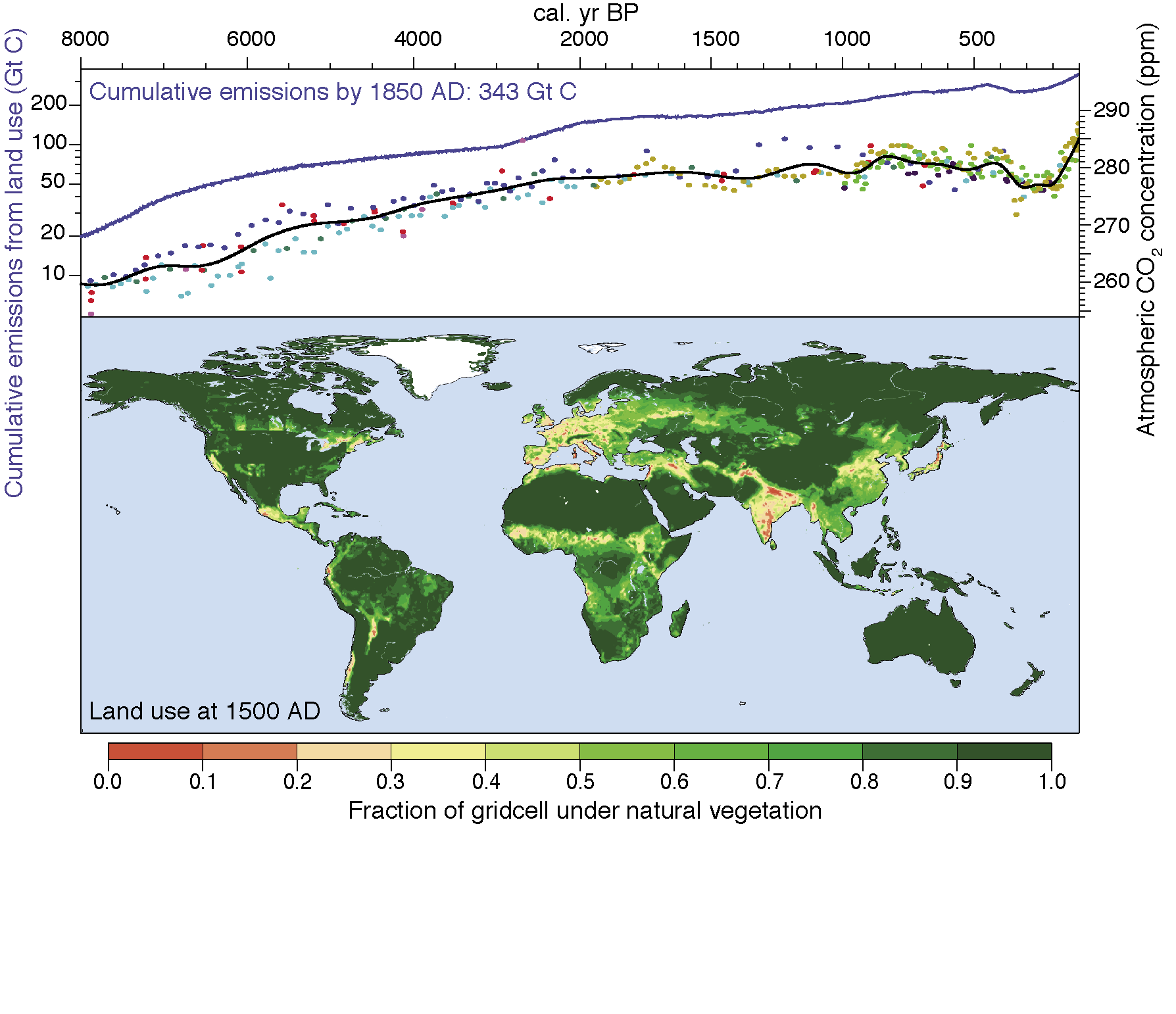- Home
- Publications
- PAGES Magazine
- Land Cover Change - To What Degree Do Human Land Cover Dynamics Affect Climate Change? [Past]
Land cover change - To what degree do human land cover dynamics affect climate change? [Past]
Jed O. Kaplan
PAGES news
20(1)
23
2012
Jed O. Kaplan
ARVE Group, Swiss Federal Institute of Technology Lausanne, Switzerland; jed.kaplan epfl.ch
epfl.ch
During the 12,000 years preceding the Industrial Revolution, melting ice sheets, stabilizing sea level, and changes in temperature and precipitation patterns influenced global land cover. Over the same period, humans adopted agriculture, domesticated animals, developed metallurgy and other technologies, and evolved in their social and cultural systems. These changes led to exponential growth in human populations, urbanization, and the expansion of human settlements to the entire ice-free area of the world. Both human-induced and natural environmental change over the Holocene resulted in the transformation of the Earth’s system by modifying land cover and through emissions of greenhouse gases and aerosols.
Preindustrial anthropogenic activities, mainly deforestation, rice cultivation, and domestication of ruminants, resulted in substantial emissions of CO2 and CH4 to the atmosphere. This change in greenhouse gas concentrations could have affected global climate to the point of precluding the inception of a new glacial period (Ruddiman 2003; Ruddiman et al. 2011). Ruddiman based his analysis on orbital forcing, thought to be the ultimate cause of ice age inception, and atmospheric CO2 and CH4 concentrations measured in ice cores. He concluded that greenhouse gas concentrations in the Holocene showed anomalous trends when compared to previous interglacials. Ruddiman’s analysis has been criticized on the alignment between orbital forcing and greenhouse gas records, and because most previous interglacials show a time trend in orbital forcing that is not completely analogous to the Holocene. There is one undisputed feature of the Holocene, however, that we know makes this epoch different from the rest of Earth history: the existence of behaviorally modern humans.
The earliest significant impact humans probably had on large-scale land cover is the application of fire for the improvement of hunting and gathering opportunities. Even extremely low population densities can radically change land cover using fire (Bowman 1998; McWethy et al. 2009). Where an obvious anthropogenic trend is not identified in synthesis of charcoal records from sedimentary archives (Marlon et al. 2008) this may be a result of the fact that we have no appropriate baseline without human influence with which to assess the data, e.g. from previous interglacials.
With the Neolithic revolution, the human interaction with the landscape changed completely, with large areas of natural vegetation converted to cropland and pasture. Outside of river floodplains, early agriculture was inefficient, and meant that early farmers used much more land per capita than observed even in late preindustrial societies. Deforestation for agricultural land use and exploitation of forest resources for fuel, construction materials, and nutrients meant that human impact on the global carbon cycle could have been substantial (Fig. 1; Kaplan et al. 2011). Furthermore, beginning in the mid-Holocene, the spread of wet rice cultivation in Asia (Fuller et al. 2011) and the production of charcoal for metal smelting would have led to large increases in CH4 emissions over natural levels. Thus, anthropogenic activities could have caused the increases in atmospheric CO2 and CH4 concentrations observed over the last 6 ka.
While anthropogenic activities may have stabilized or increased greenhouse gas concentrations leading to a warmer global climate than would have occurred otherwise, the biogeophysical impact of deforestation and increases in aerosols could have had contrasting effects. Cooling could have occurred as a result of increased surface and atmospheric albedo, though climate-modeling experiments have shown that these effects are limited to the region where land cover change occurred. Furthermore, preindustrial human activities affected the global hydrological balance: deforestation leads to reductions in evapotranspiration and increases in runoff; these alterations could also have led to seasonally contrasting changes in regional climate. Anthropogenic activities probably had an influence on regional and global climate over the Holocene, long before the Industrial Revolution.
selected references
Full reference list online under: http://pastglobalchanges.org/products/newsletters/ref2012_1.pdf
Fuller DQ et al. (2011) The Holocene 21(5): 743-759
Kaplan JO et al. (2011) The Holocene 21(5): 775-791
McWethy DB et al. (2010) PNAS 107(50): 21343-21348
Marlon JR et al. (2008) Nature Geoscience 1: 697-702
Ruddiman WF, Kutzbach JE and Vavrus SJ (2011) The Holocene 21(5): 865-879
